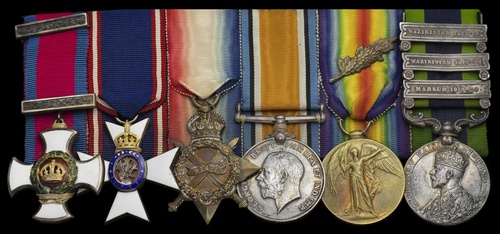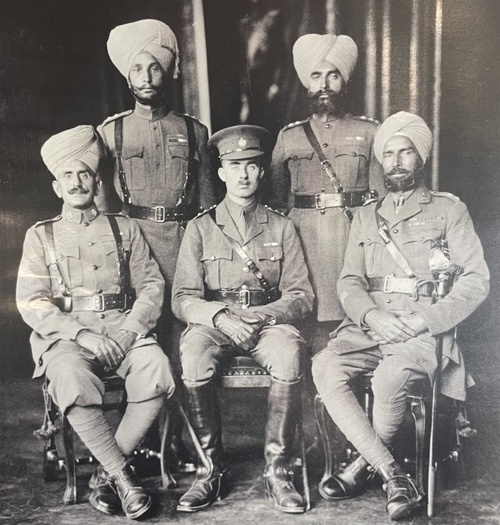Auction: 24003 - Orders, Decorations and Medals
Lot: 175
(x) A fine Great War ‘Battle of Ctesiphon’ D.S.O. and M.V.O. group of six awarded to Lieutenant-Colonel G. van Rossum Reyne, 76th Punjabis
van Rossum Reyne notched up no less than four 'mentions' during the Great War and was wounded and taken Prisoner-of-War at the Fall of Kut - he was lucky indeed to come out with his life and went on to earn his second decoration for his command of the King’s Indian Orderly Officers
Distinguished Service Order, G.V.R., silver-gilt and enamel, top riband brooch adapted for mounting; The Royal Victorian Order, Member's (M.V.O.) breast Badge, silver-gilt and enamel, reverse officially numbered '1066'; 1914-15 Star (Capt. G. Van Rossum Reyne. 76/Punjabis.); British War and Victory Medals, with M.I.D. oak leaves (Capt. G. V. R. Reyne.); India General Service 1908-35, 3 clasps, Mahsud 1919-20, Waziristan 1919-21, Waziristan 1921-24 (Major G. Van R. Reyne. 2-76 Pjbis.), third clasp affixed with cotton, mounted court-style as worn by Spink & Son, 17 & 18 Piccadilly, good very fine (6)
D.S.O. London Gazette 19 October 1916. Awarded for the battle of Ctesiphon in November 1915 (History of the 76th Punjabis 1914-21, refers).
M.V.O. London Gazette 2 August 1919:
‘British Officer in charge of the King’s Indian Orderly Officers.’
M.I.D. London Gazette 5 April 1916, 13 July 1916, 19 October 1916, and 30 December 1918.
Gerard van Rossum Reyne was born on 29 March 1886, son of Major J. F. Reyne, late 37th Foot. He was educated at Wellington and Sandhurst, and was appointed 2nd Lieutenant, attached 2nd Cheshire Regiment, on 5 August 1905. Reyne was posted to the 76th Punjabis on 7 December 1906.
Reyne served during the Great War in Mesopotamia from November 1914 until the fall of Kut in April 1916. As part of the Suez Canal defence force he was present at the repulse of Djemal Pasha’s determined attack on the canal on 3 February 1915. The subsequent pursuit of the Turkish forces saw Reyne in all the ensuing operations of the 76th Punjabis on the Euphrates.
The British advance to capture Baghdad ground to a standstill with the four-day battle of Ctesiphon at the end of November 1915. During the battle the 76th suffered 289 casualties, including the C.O. killed - with Reyne taking his decorations. General Townshend now decided to fall back on Kut-al-Amara, the advanced base, and await relief. His weary British and Indian troops, including the 76th Punjabis, stumbled into Kut on 3 December and were immediately encircled and besieged by the Turks. Reyne was wounded in the defence and began to notch up his 'mentions'.
By the time Townshend surrendered to the Turks on 29 April 1916, the daily ration for British officers and men was 4 ounces of bread, usually dropped by the Royal Flying Corps, and 16 ounces of meat, normally from dead mules as the horses had long since been killed and eaten. Reyne and seven other officers and 240 men of his Battalion were among the garrison that passed into captivity and the infamous ‘death march’ to Turkey. Out of the 227 officers and more than 12,000 other ranks who walked, or were carried, out of Kut, a staggering 70% died whilst in captivity. A series of wartime drawings by Captain Rybot, a Battalion comrade, are now preserved in the Imperial War Museum, London, where they are catalogued under ‘Kut Frescoes’. During his captivity Reyne was held at several Turkish camps. In July 1916 he was at Kastamuni and then at Changri, and Afion Kara Hissar, which he left on 21 December 1917. He left the camp at Kedos in September 1918 and was finally held at Smyrna (From Kastamuni to Kedos, Captain Woolley, refers).
Appointed M.V.O. in August 1919 for services as the British Officer in charge of the King’s Indian Orderly Officers, Reyne went to Waziristan at the end of that year to participate in the operations against the unruly Mahsud tribes. He was promoted to Major in August 1920, to Lieutenant-Colonel in 1930, retired in 1933.
With the outbreak of the Second World War, he returned to the fold as a Volunteer with the 25th (Hampshire) Battalion, Home Guard. Reyne died on 24 July 1940 and is buried in the Yateley (St Peter) Churchyard, near Sandhurst, there being 7 Commonwealth War Graves Commission burials there; sold together with copied research and several images of the recipient, including with his Indian Orderly Officers.
Subject to 5% tax on Hammer Price in addition to 20% VAT on Buyer’s Premium.
Sold for
£4,000
Starting price
£1900









